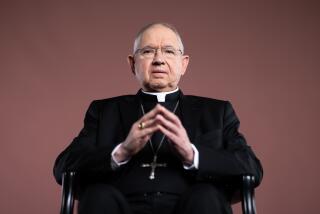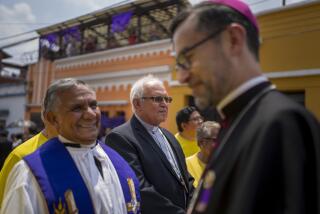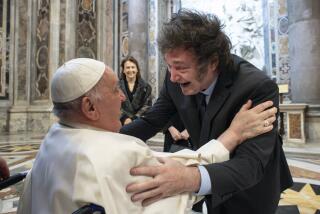Sacred Sojourn
- Share via
Many came seeking miracles, large and small: a cure for an ailing loved one, a way out for a troubled youngster, hope for a failed marriage.
But all visiting the Eastside church seemed thrilled simply to have a spiritual conversation with the highly adorned figure known as la generala--the general, after the role she is credited with in preventing a blood bath during the Mexican War of Independence more than a century and a half ago.
“You can talk to la generala like a friend,” said Guadalupe Martinez, beaming after asking the Virgin to watch over her eight children.
The object of her veneration was the likeness of Our Lady of Zapopan, patroness of the Mexican state of Jalisco, a region that has long been a primary source of immigrants to the United States.
The much-beloved image--second in importance only to the Virgin of Guadalupe in Roman Catholic iconography in Mexico--is nearing the end of a three-week swing through churches in Southern California. Thousands paid homage to the traveling icon, actually a carved cedar replica of the fragile, 16th century original housed in its own basilica in Zapopan, outside Guadalajara.
The heavy turnout, and obvious degree of transnational fondness, is yet another indication of the social and cultural links that transcend the physical border that separates Mexico and Southern California. This is the eighth consecutive year that the Virgin has toured area churches.
“People may live far away, but they do not lose the desire to see their beloved images,” noted Father Angel Cordero, a Benedictine priest and religious art historian who was visiting Santa Isabel Church in Boyle Heights this week, where the Virgin’s visit was concluding.
The Virgin is about 1 1/2 feet tall, resembling an elaborately appointed porcelain doll. At Santa Isabel, she was positioned on her wooden pedestal inside a plexiglass case set above the altar. The Virgin’s garments vary--her handlers dress her differently depending on the day, gently combing her hair beneath a crown or hat--but she always dons her trademark blue military sash beneath her triangular cape and carries a gold pastor’s staff.
Transporting such an object more than 2,000 miles presents a logistic challenge. But church officials say the trip has been smooth.
“Everything has gone off very well,” said Father Martin Angel Navarro, ordained a Franciscan priest in Mexico only a month ago. He has been the Virgin’s constant companion on this trip, along with a Franciscan brother, Carlos Zepeda.
The icon and her entourage arrived by plane from Mexico. She travels in a specially designed, padded case and has been driven to sites in Los Angeles.
Wherever she goes, celebrations of the Mass and rhythmic recitations of the rosary accompany her, along with occasional shouts of “Viva la generala!” Enterprising salespeople hawk her image outside the churches for a few dollars. Supplicants show respect by approaching on their knees. Many light candles and provide donations. Others leave milagros, tiny metal talismans traditionally linked to miracles. Throughout the Catholic world, certain images of the Virgin and other sacred figures have long been associated with miraculous deeds.
“I asked for a miracle for my nephew,” said Alicia Ramirez, 52, who declined to be more specific about her secret request, revealing only that May 27 would be a crucial day for him. “I pray justice is done,” Ramirez said hopefully as she left the brick church, which was festooned with cheerful arrangements of flowers and red and yellow ribbons.
Men and women of all ages paid their respects. Most were Mexican immigrants long acquainted with the Virgin. Indeed, many had called on her back home and credited la virgencita with curing sick relatives. All were thrilled to see the familiar figure so far from home, even if it wasn’t the original.
“For me, she means hope,” said Martin Chavez, recently arrived from Jalisco, who was dressed in shorts, a white T-shirt and a cloth image of the Virgin of Guadalupe, Mexico’s preeminent religious symbol.
The 21-year-old restaurant helper said he asked the Virgin to keep him out of trouble with drugs and other vices that are temptations here. Said Chavez, “I can’t lose hope.”
Gloria Gasca, a 16-year-old volunteer at the church, said the display of faith heartened her. “Even though things can be so corrupt,” she noted, “people still believe.”
This Sunday, the Virgin will don a broad-brimmed traveler’s hat and scarf in anticipation of her scheduled return the next day to Mexico. Her despedida, or farewell, will be special: Santa Isabel parish plans a mariachi Mass on Sunday to send her off.
More to Read
Sign up for Essential California
The most important California stories and recommendations in your inbox every morning.
You may occasionally receive promotional content from the Los Angeles Times.











